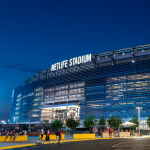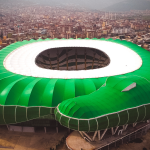
How Coronavirus will change the stadium
The structural and behavioral changes we will have to get used to
June 8th, 2020
There are basically two categories of football fans: those who go to the stadium and those who prefer to watch a game from a screen. Those who are part of the first group know that the stadium, understood as a structure, is a fundamental part of the magic of the sporting event, and the crowd that fills it englobs the spectator in a bond with the strangers around us. And it is precisely the involvement, the choral atmosphere, the filling presence of the crowd inside the stadium that leads a child to say "I want to go there again". But for everyone, especially for those who have just tasted this experience, the biggest disappointment is coming.
In fact, the coronavirus that forced businesses and restaurants to apply metric distances between consumers will not spare the stadiums that welcome thousands of spectators every weekend. If the training centers are not a problem because they are kept off-limits, the stadium is instead a more complicated question: therefore no more stadium experience and many greetings to the community sense if not for the big stadiums, for which good results have been found solutions.
Large spaces, great solutions
Like all social places in the city fabric, a football facility to reopen to the public must necessarily prepare for routine checks, that is, screening and strict observance of distances; for this reason the stadium - a large stadium - can actually be more advantageous than the others. Large capacity also means greater freedom of management of control activities: in the subdivision of the stadium area designed by the Football League - following the German model - zone 3 corresponds to that outside the system, where according to the rules only operators can pass tv and law enforcement.
The most important stadiums in Europe are all located in non-central areas of the urban fabric and surrounded by large empty spaces: they are used to encourage the flow and outflow of people, but also to conceptually delimit the sports space within a city. The Giuseppe Meazza in Milan, the Olimpico in Rome, the Allianz Arena in Munich and the Juventus Stadium in Turin are just a few examples of stadiums with a belt of free space around them, much more numerous than the contrary examples, such as the Bernabeu of Madrid, the Stamford Bridge or the Camp Nou in Barcelona. In a situation of necessary respect for distances, these areas are essential for orderly and easily manageable traffic, which is why it is easier to enforce the distances around the aforementioned plants.
And if the question also addressed the plants to be built, such as the new stadium in Milan, the answer would not change: building a stadium in the center, in an area urbanistically crowded with buildings and structures, does not seem to be an excellent move. In this new perspective, the stadium should have a large surrounding area, not only for those marketing reasons that clubs like so much, but also because if the request is for a distance friendly structure, the urban design of a space concave is not needed. The project by the Populus architects' studio for the new stadium in Milan proposed a winning rendering focused on maximizing the match experience and, throughout Europe, this is the model used most frequently. But from post covid-19 onwards, the stadium effect will no longer have the same parameters: the large adjacent shopping centers, for example, will have to be designed with a philosophy aimed at open spaces, with the ability to neatly accommodate a consistent flow of people; the opportunity to build a commercial site from scratch, as well as a stadium, will have to be optimized to allow for the maintenance of safety distances. And if football cannot melt from marketing, then it is the case that they change together.
''Siri, look for the Italian Cup final tickets''
Before coronavirus, smart-working, green projects and e-commerce were concepts that already existed in society but in an almost obligatory way they were stimulated by pandemic needs. And so, even in football, the theory of modernizing plants will see its apotheosis; the rhetorical chain that exalted the Anglo-German systems and that condemned the backwardness of the Italian stadiums this time is right: manual checks and confusion at the entrances will no longer be acceptable. The idea of the hi-tech stadium has become a need to update the stadium experience not only in the near future, but also in the following decades. Anyone who is a fan of the stadium and has a habit of attending curves and grandstands will have to become familiar with the QR codes or with the app that will allow us to choose places in the cinema. On the other hand, is there perhaps a difference between a seat and an armchair?
The universe of furniture will enter the world of football even more with the online management of pre-match activities and, therefore, here is the boom in tickets and electronic documentation; moreover, when we talk about the importance of large spaces, reference is also made to screening activities: more spatial width also corresponds to better traffic flow for people and, from this, facial recognition operations will also benefit, given that must remove the mask using plexiglass barriers for a quick check-in. But in all this it is understood that the number of spectators at the stadium will have to decrease.
As witnessed by architect Mark Fenwick at Corriere della Sera, "the reduction of capacity to increase the space between spectators and the use of no-touch technology" must be the new mantra for the architecture of the stadium of the future. Sold out scenes and box office queues must look like photographs of the past, at least for next season. Capacity is and will be for a long time the key concept for the rethinking of stadiums, whose philosophy will change from "mass hospitality" to "essential reduction". The Juventus Stadium, in this sense, is one of the best structures. And so also the next cranes in action in Milan, Cagliari and Florence (cities committed to renovating the plants) will work for a reduced capacity, instead of choosing to increase the cheering space. Furthermore, it was said that fans at the stadium will be asked to remain seated and not get up - in the face of the Yellow Wall in Dortmund - explaining that this is one of the fundamental methods to avoid filling the safety distances and creating gatherings. But it is not a trivial matter: for those who live the stadium experience, sitting is not such an underlying request.





















